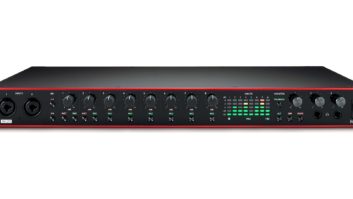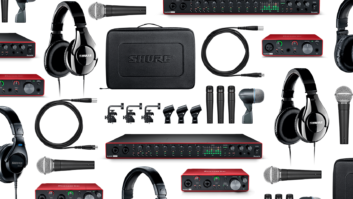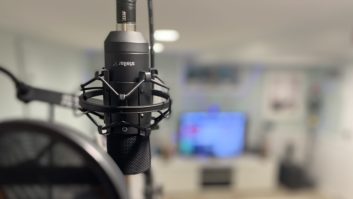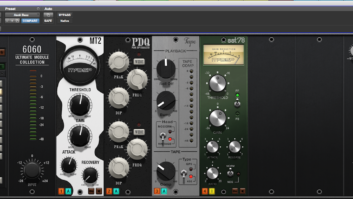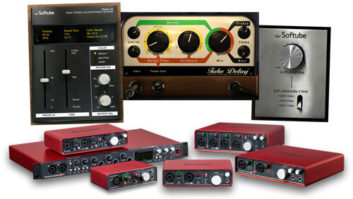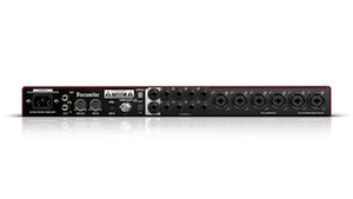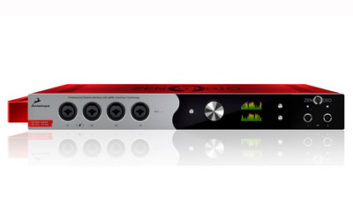The third generation of the Focusrite Scarlett series of USB 2.0 interfaces has arrived and it offers quality sonics and features for a surprisingly low price. This review focuses on the flagship of the line, the 18i20, which includes a generous assortment of onboard I/O and expansion capabilities.

Focusrite redesigned the preamps and electronics in the third generation of Scarlett interfaces, resulting in improved dynamic range and reduced noise and distortion specs. It also added optional AIR functionality to each input channel. AIR emulates the transformer-based sound of the company’s vaunted ISA mic preamps.
All of the Scarlett third-generation interfaces are tabletop units, including the 18i20; it’s also the only one that can be rackmounted thanks to a pair of included rack ears.
START ‘EM UP
Focusrite made it easier to get up and running on your Scarlett with the inclusion of the software Quick Start Tool (for Mac and Windows). When you connect the unit to your computer through the USB port, you’ll see a Scarlett icon appear on your desktop. During the Quick Start process, the interface functions as a mass storage device.
Clicking the icon activates the Quick Start Tool (the process is a bit simpler on the Mac than on the PC), which brings you to the Focusrite website. There, you’re urged to register your hardware and are offered instructional videos based on your answers to a series of questions.
During the Quick Start process you’re also directed to download the Focusrite Control software. Some of the functionality is redundant to the hardware switches and knobs, but you can access many essential features (particularly in the area of setting up monitor mixes) only through the software (much more on that later).
The Quick Start Tool also gives you access to your downloads and license info for the included third-party software, which consists of Avid Pro Tools First, Ableton Live Lite, the Focusrite Red 2 & 3 Plug-in Suite, Softube’s Time and Tone Bundle and XLN Audio Addictive Keys. Registering your interface also gives you membership in the Focusrite Plug-in Collective, which periodically offers significant discounts on music software.
I/O YOU
Without question, one of the strengths of this unit is its analog inputs and outputs. You get a total of eight combo inputs. You can use the two front-panel inputs for mic, line or instrument connections. Six more on the back can handle mic or line signals.
All eight input channels have corresponding input gain knobs on the front, as well as individual -10dB Pad switches. They don’t offer highpass filters, however. Channels 1 and 2 have INST switches to configure them to accept high-impedance signals. You can switch phantom power on in blocks of four channels: 1-4 and 5-8.
A front-panel matrix of 5-step LED meters provides an easy-to-see visual representation of input levels. The top step glows red when clipping occurs. You can also see a more detailed view of levels from inside the Focusrite Control software. On the output side, you get 10 ¼-inch TRS outputs. Eight are line outputs, and the other two are a stereo pair for monitors.
If you need to expand beyond the built-in I/O, two pairs of optical TOSLINK connectors allow you to add up to eight channels of additional inputs and outputs of ADAT digital audio. You also get two channels of S/PDIF on RCA jacks.
Two independently addressable TRS headphone jacks, each with a volume control, are located on the front panel next to the monitor level knob. The knob defaults to controlling the monitor outputs but can be switched in Focusrite Control to control another pair of analog outputs.
MIDI In and Out jacks are also provided, offering another option for connecting your MIDI controller and other devices. Also included is a BNC Word Clock output for synching other digital audio gear.
CONTROL AND FOCUS
The 18i20 offers an excellent selection of monitor-control features, which you can access either with hardware switches or through the software. Among them are Dim, Mute and Talkback buttons. The talkback circuit has a built-in mic, which is handy.
You use the front panel Alt button for speaker switching. Although there’s only one dedicated monitor output pair, you can designate any other set of outputs to be the alternate speakers—again, using Focusrite Control—and then switch between them from the front-panel button.
The Focusrite Control software is integral to the workflow of the 18i20. Reconfigured for the third-generation interfaces, it’s pretty straightforward to use, which is a nice change from many such software mixers, which tend to be user-unfriendly.
Focusrite Control has two main sections: Input Settings and Output Routings. In the former, you see each channel and can turn on and off the Air and Pad functionality on a per-channel basis. For channels 1 and 2, you can also switch on the Instrument level option. The Output Routing section shows you graphic representations of all the outputs on the unit and lets you configure which input sources are feeding them.
Loopback functionality is also included, allowing you to capture computer audio sources along with external ones. This feature is particularly useful for podcasters and others creating live content.
Once you’ve configured the input and output assignments in Focusrite Control, the 18i20 will remember those settings the next time it’s turned on. As a result, you can preconfigure the unit and then use it without the computer should the need arise. One example of how you could take advantage of computer-less operation is for a live recording setup.
DIRECT TO HEADPHONES
Focusrite Control’s most important function is setting up headphone mixes. You can configure a stereo monitor mix for each output pair on the unit. If you’re using an expansion unit through the ADAT optical jacks, you can also create mixes for those outputs.
What’s more, by clicking off the Stereo button on any of the output pairs in the software, you get two mono outputs. So, if you needed a lot of different monitor mixes, you could create twice as many mono ones.
Focusrite Control offers a nicely designed and very graphic user interface. Each output pair has a pulldown menu that lets you choose from several different preset routing options or select Custom Mix.
The preset options include direct routing, 2-channel analog recording, analog plus digital, and so forth. If you’re hosting a session with many musicians who all need separate mixes, you’ll probably want to set them up using the Custom Mix option. It allows you to configure your own mixes. You can choose which inputs will be available in each mix and adjust their levels separately with sliders.
The input sources in the mixes are all pre-computer, so latency is not an issue if you monitor directly. That’s how the 18i20 can compete in the same market with much faster Thunderbolt and USB 3.0 interfaces. The only drawback is that the 18i20 doesn’t offer built-in effects to use when monitoring, so musicians and singers will hear themselves dry.
I replaced my regular studio interface with the 18i20 for a couple of weeks during the testing period for this review. I used it to record several projects during that time. I tracked electric and acoustic guitars, bass, resonator guitar, mandolin and vocals through the unit, and the results were quite good and were on par with my regular interface, which is a much more expensive unit.
I liked having the option of turning on the Air feature. The preamps sounded more present with it on and provided a more transformer-like vibe. That said, I was glad that Focusrite made it switchable because there were some sources I recorded which I felt sounded better and more natural with the Air turned off. Overall, the sound quality of the 18i20 was impressive.
If you’re looking for an interface with eight built-in mic preamps, the 18i20 is one of the best values on the market. Yes, it has some limitations, such as lack of effects for direct monitoring or highpass filters on the inputs. But if you’re setting up a studio where you want to be able to record a lot of sources with quality on a limited budget, or if you’re looking to expand your current ADAT-equipped setup, the 18i20 is an excellent option. If you don’t need as many inputs, you can spend less and get the same quality with one of the other Scarlett interfaces.
PRODUCT SUMMARY
COMPANY: Focusrite
PRODUCT: Scarlett 18i20 (third generation)
WEBSITE: focusrite.com
PRICE: $499
PROS: Excellent sound quality for the money; witchable Air feature provides transformer-like sound; 8 onboard mic preamps; 8 analog outputs; front-panel volume and pad switches for all inputs; well-designed metering; dim, Mute, and speaker switching functions; built-in talkback mic; configurable standalone operation; expanded functionality through Focusrite Control Software
CONS: No effects for direct monitoring; no highpass filters on inputs; phantom power not individually switchable
